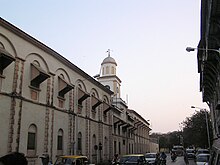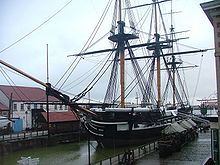Bombay Dockyard
The Bombay Dockyard in Mumbai , India , also known as the Naval Dockyard , founded in 1735 , is the Indian Navy's largest equipment and overhaul yard .
task
The site covers approximately 55 hectares, with over 4 kilometers of quays . The shipyard is under the command of an Admiral Superintendent with the rank of Vice Admiral and employs more than 10,000 people, most of them civilian personnel. The shipyard's task is the maintenance, overhaul and modernization of ships and submarines of the Indian Navy. As far as the capacities allow, the shipyard also carries out repairs and equipping or upgrading ships of other authorities and private owners for a corresponding payment.
history
Shipbuilding is believed to have been in operation on the site of the present shipyard since at least 1671, but the history of the Bombay Dockyard begins in 1735. The British East India Company , which moved its headquarters from Surat to Bombay (now Mumbai) in 1668 , brought the Indian shipbuilder Lovji Nusserwanji Wadia ( Wadia = shipbuilder) from Surat, where people were concerned about the lack of oak , to Bombay so that he should build a shipyard there and build ships for them. He and the next seven generations of Wadias the company served for 150 years as a shipwright and built more than 400 ships with Malabar - teak . The Bombay Dock, the first dry dock in Asia, began operating in 1750.
Between 1735 and 1856, 170 warships were built for the British East India Company, 34 warships for the British Royal Navy and 87 merchant ships there. The pride of the shipyard from this period is the 46-cannon frigate Trincomalee , built in 1817 and weighing 1065 tons, which today is the second oldest floating sailing warship in the world after the Constitution ; she is docked in the historical part of the docks of Hartlepool in England as a museum ship .
With the transition to iron as the main material in shipbuilding, the shipyard's mission changed from shipbuilding to repair and maintenance in 1884.
On August 14, 2013, the submarine INS Sindhurakshak (S63) exploded in the shipyard.
Investments
- The Bombay Dock is the oldest dry dock in Asia. Though there had been considerations of building a dock since the East India Company moved to Bombay in 1668, construction did not begin until 1735 under the direction of Lowji Nusservanji Wadia. The facility consists of three dock chambers in a row, the “Upper Old Bombay Dock” (built 1750), the “Middle Old Bombay Dock” (1762) and the “Lower Old Bombay Dock” (1765). This arrangement was chosen because three small ships or one large and one small ship could be docked at the same time and because with good planning a ship could remain undisturbed in the upper dock for a long time, while the two lower docks could be used for ships with shorter dwell times .
- The Duncan Dock, named after a former governor of Bombay, consists of two dry docks, the Upper Duncan Dry Dock built in 1807 and the Lower Duncan Dry Dock built in 1810.
- The so-called Wet Basin was built in 1889. It is closed by means of an 18 meter wide dock lock so that the water level inside is independent of the tide change .
- The torpedo dock adjoining the Wet Basin and also closable with a dock lock, so called because it was initially intended for torpedo boats , was built in 1890 and expanded in 1944 to accommodate larger ships and submarines .
The main administration building was built in 1807.
The most prominent among the historical buildings of the complex is the " Bombay Castle ", the former headquarters of the British East India Company and residence of the governor.
Well-known ships built in the Bombay Dockyard
- HCS Bombay . The Ghurab , built in 1739, was the first ship built in the shipyard and the first of a total of ten warships of that name that have been built here to this day. She was 27 meters long and armed with 24 cannons, was the second largest warship of the British East India Company at the time, and served the Honorable Company for 50 years.
- HMS Minden . The Royal Navy ship of the 3rd rank was launched in 1810. She was the first Royal Navy ship to be built outside the British Isles. She served in Chesapeake Bay during the War of 1812 between the United States of America and Great Britain . Francis Scott Key is said to have been a prisoner aboard the Minden off Baltimore when he wrote the first verse of the later American national anthem The Star-Spangled Banner .
- HMS Cornwallis : The Royal Navy's 74-gun ship of the line 3rd rank was built in 1813. On it was in August 1842 in the port of Nanjing the Treaty of Nanking negotiated with the First Opium War between Britain and China has been completed and the UK "eternal ownership" on the island of Hong Kong gained.
- HMS Trincomalee . The Royal Navy's 38-gun, 1447-ton frigate was launched on October 12, 1817. She is the second oldest floating sailing warship in the world and is now docked in Hartlepool on the north-east coast of England.
- HMS Asia : The Royal Navy ship of the line, equipped with 84 cannons, was launched in January 1824 and was the flagship of Admiral Edward Codrington at the Battle of Navarino on October 20, 1827.
- HMS Bombay . The Royal Navy's 84-gun ship of the line, 2nd rank, was launched in 1828. It was equipped with a screw drive in 1861. When a fire broke out on board for unknown reasons during a target shooting near Flores Island in the Río de la Plata on December 14, 1864, the ship's ventilation system quickly spread the fire over the entire ship, which resulted in 86 men of its 616 men Occupation was lost.
visit
A so-called "Heritage Walk" takes place on the first Sunday of each month, during which visitors are guided through the historical parts of the complex. However, only Indian citizens are allowed to participate.
Coordinates: 18 ° 55 ′ 43 ″ N , 72 ° 50 ′ 28 ″ E
Individual evidence
- ^ HCS = Honorable Company's Ship
literature
- David Arnold: The New Cambridge History of India: Science, Technology and Medicine in Colonial India , Cambridge University Press, 2004, ISBN 0-521-56319-4

